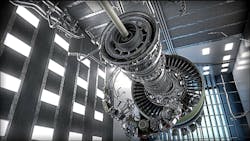New Design, Composite Material for GE Aviation Engine Blades
GE Aviation is designing a new, thinner turbine fan blade for its GE9X engine, to be produced in a new carbon-fiber composite material, a change it said would improve airflow through the engine thus making it operate more effectively and with reduced fuel consumption. The redesign will mean the GE9X has fewer blades, and thinner blades, than any other GE turbofan engine for wide-body aircraft.
The builder stated it expects the new version to achieve a 10% increase in fuel efficiency over the standard version of the GE9X engine.
GE Aviation indicated it would invest $300 million this year to test the new engine design, including Universal Propulsion Simulator (UPS) fan performance tests, and tests of the ceramic matrix composite components.
The GE9X is a slightly smaller variant of the GE90 high-bypass turbofan engine, developed specifically for the Boeing 777-8x/9x aircraft by GE Aviation, IHI Corporation, Safran, and MTU Aero Engines AG
Almost 700 GE9X engines have been ordered by customers since it was introduced on the Boeing 777X in 2013.
As detailed by GE, the GE9X has a 133-inch diameter composite fan case and 16 composite fan blades; a 27:1 pressure ratio 11-stage high pressure compressor; a TAPS (twin annular pre-swirl) combustor for greater efficiency and low emissions; and ceramic matrix composite material for the combustor and turbine, as well as the blades.
"It has been a decade since GE designed a new composite fan blade for the GEnx engine," explained Bill Millhaem, general manager of the GE90/GE9X engine programs. "Carbon-fiber composite material has advanced in those 10 years, and the advancements enable GE engineers to design a thinner GE9X blade, which is just as strong as our current composite fan blades. Fewer, thinner blades will enhance the airflow and make for a lighter, more efficient fan that will help with the GE9X engine's overall performance and fuel burn."
The new material is made using a higher stiffness carbon fiber and a new epoxy resin. Also, the material on the leading edge of the blades will be converted from titanium to a steel alloy, strengthening the blades.
Last year, according to GE, its developers received positive results from material testing on full-sized GEnx blades.
Testing of the new material is ongoing: The first “full core” test of engines made using the new design blades is set for 2015. The first engine will test in 2016, with flight testing in 2017. Engine certification is anticipated for 2018.
About the Author
Robert Brooks
Content Director
Robert Brooks has been a business-to-business reporter, writer, editor, and columnist for more than 20 years, specializing in the primary metal and basic manufacturing industries.
